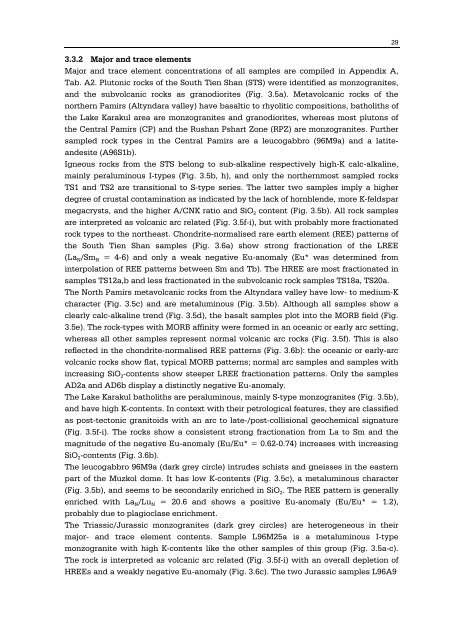tübinger geowissenschaftliche arbeiten (tga) - TOBIAS-lib ...
tübinger geowissenschaftliche arbeiten (tga) - TOBIAS-lib ...
tübinger geowissenschaftliche arbeiten (tga) - TOBIAS-lib ...
You also want an ePaper? Increase the reach of your titles
YUMPU automatically turns print PDFs into web optimized ePapers that Google loves.
3.3.2 Major and trace elements<br />
Major and trace element concentrations of all samples are compiled in Appendix A,<br />
Tab. A2. Plutonic rocks of the South Tien Shan (STS) were identified as monzogranites,<br />
and the subvolcanic rocks as granodiorites (Fig. 3.5a). Metavolcanic rocks of the<br />
northern Pamirs (Altyndara valley) have basaltic to rhyolitic compositions, batholiths of<br />
the Lake Karakul area are monzogranites and granodiorites, whereas most plutons of<br />
the Central Pamirs (CP) and the Rushan Pshart Zone (RPZ) are monzogranites. Further<br />
sampled rock types in the Central Pamirs are a leucogabbro (96M9a) and a latiteandesite<br />
(A96S1b).<br />
Igneous rocks from the STS belong to sub-alkaline respectively high-K calc-alkaline,<br />
mainly peraluminous I-types (Fig. 3.5b, h), and only the northernmost sampled rocks<br />
TS1 and TS2 are transitional to S-type series. The latter two samples imply a higher<br />
degree of crustal contamination as indicated by the lack of hornblende, more K-feldspar<br />
megacrysts, and the higher A/CNK ratio and SiO 2 content (Fig. 3.5b). All rock samples<br />
are interpreted as volcanic arc related (Fig. 3.5f-i), but with probably more fractionated<br />
rock types to the northeast. Chondrite-normalised rare earth element (REE) patterns of<br />
the South Tien Shan samples (Fig. 3.6a) show strong fractionation of the LREE<br />
(La N/Sm N = 4-6) and only a weak negative Eu-anomaly (Eu* was determined from<br />
interpolation of REE patterns between Sm and Tb). The HREE are most fractionated in<br />
samples TS12a,b and less fractionated in the subvolcanic rock samples TS18a, TS20a.<br />
The North Pamirs metavolcanic rocks from the Altyndara valley have low- to medium-K<br />
character (Fig. 3.5c) and are metaluminous (Fig. 3.5b). Although all samples show a<br />
clearly calc-alkaline trend (Fig. 3.5d), the basalt samples plot into the MORB field (Fig.<br />
3.5e). The rock-types with MORB affinity were formed in an oceanic or early arc setting,<br />
whereas all other samples represent normal volcanic arc rocks (Fig. 3.5f). This is also<br />
reflected in the chondrite-normalised REE patterns (Fig. 3.6b): the oceanic or early-arc<br />
volcanic rocks show flat, typical MORB patterns; normal arc samples and samples with<br />
increasing SiO 2-contents show steeper LREE fractionation patterns. Only the samples<br />
AD2a and AD6b display a distinctly negative Eu-anomaly.<br />
The Lake Karakul batholiths are peraluminous, mainly S-type monzogranites (Fig. 3.5b),<br />
and have high K-contents. In context with their petrological features, they are classified<br />
as post-tectonic granitoids with an arc to late-/post-collisional geochemical signature<br />
(Fig. 3.5f-i). The rocks show a consistent strong fractionation from La to Sm and the<br />
magnitude of the negative Eu-anomaly (Eu/Eu* = 0.62-0.74) increases with increasing<br />
SiO 2-contents (Fig. 3.6b).<br />
The leucogabbro 96M9a (dark grey circle) intrudes schists and gneisses in the eastern<br />
part of the Muzkol dome. It has low K-contents (Fig. 3.5c), a metaluminous character<br />
(Fig. 3.5b), and seems to be secondarily enriched in SiO 2. The REE pattern is generally<br />
enriched with La N/Lu N = 20.6 and shows a positive Eu-anomaly (Eu/Eu* = 1.2),<br />
probably due to plagioclase enrichment.<br />
The Triassic/Jurassic monzogranites (dark grey circles) are heterogeneous in their<br />
major- and trace element contents. Sample L96M25a is a metaluminous I-type<br />
monzogranite with high K-contents like the other samples of this group (Fig. 3.5a-c).<br />
The rock is interpreted as volcanic arc related (Fig. 3.5f-i) with an overall depletion of<br />
HREEs and a weakly negative Eu-anomaly (Fig. 3.6c). The two Jurassic samples L96A9<br />
29

















